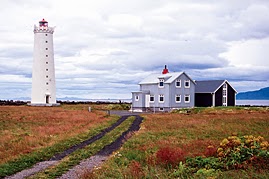A small
detour: Does anyone know if the word “aspire” originates from “spire”? It seems
likely.
The first
lighthouse in Iceland was built in 1877. Before that time, most fishing was
conducted in small open boats and almost inclusively during daylight. No one
was particularly interested in coming here and under 100 trips from foreign
vessels passed the Reykjanes peninsula annually. It is worth a mention that
despite there being no lighthouses before 1877, an attempt to pass a lighthouse
tax was made. (It did not go through).
With
lighthouses came lighthouse-keepers. These men were believed to require
guidance so regulations were passed regarding their duties in 1897. Amongst the
articles found therein was one forbidding them to allow anyone drunk, dishevelled
or raggedly looking into the lighthouse.
Today there
are 104 lighthouses owned and operated by the Icelandic Maritime Authority. An
additional 30-40 belong to various municipalities and are situated at harbour
entrances.
Here are
some photos of Icelandic lighthouses for your enjoyment. It is easy to imagine
bad things happening there. I have incorporated one of them into my latest book
which came out in Iceland last November. I will allow you to guess which one
captivated the writer in me.
 |
| Dyrhólaeyjarviti - built in 1927 to replace the original built in 1910. The original did not last long for some reason. |
| Arnarnesviti - 1941
|
| Skaftárósviti - built in 1911, possibly under the influence of Eiffel's masterpeice - if you put the colour to one side. |
| Malarrifsviti - built in 1946 in the place of an iron lighthouse like the one above that gave way to rust |
 |
| Urðaviti - built in 1986 to replace the original lighthouse that went under lava in the Heimaey eruption in 1973. |
 |
| Garðskagaviti - the archetypal lighthouse design - constructed in 1944 |
Yrsa - Wednesday

















The one I'm betting interested you, Yrsa, reminds me of the Greek monasteries of Meteora set atop seemingly inaccessible cliffs. Hard to imagine that anyone making up to Þrídrangaviti wouldn't be disheveled, raggedy and soon drunk.
ReplyDeleteYou got it :-)
DeleteHow would a lighthousekeeper even make it to Þrídrangaviti?
ReplyDeleteHi Michael - there was never a lighthouse keeper at that particular location. To access it men would go by boat and climb up the side aided by a chain that was bolted into the cliff. That is how they brought the supplies for the construction onto the top. Some years later they built a helipad and after that access was via air. Now this helipad is too small for the coast guard helicopters so anyone that has to go there (replace batteries etc) goes down from the helicopter in a line.
DeleteYrsa, have you heard this?
ReplyDeletehttp://www.youtube.com/watch?v=PKtEWB0WmDE&feature=youtube_gdata_player
These are beautiful designs and so different.
ReplyDeleteI've seen some lighthouses in the States in different states, and they were not outstanding works of architectural artistry, rather plain and alike.
nice
ReplyDelete